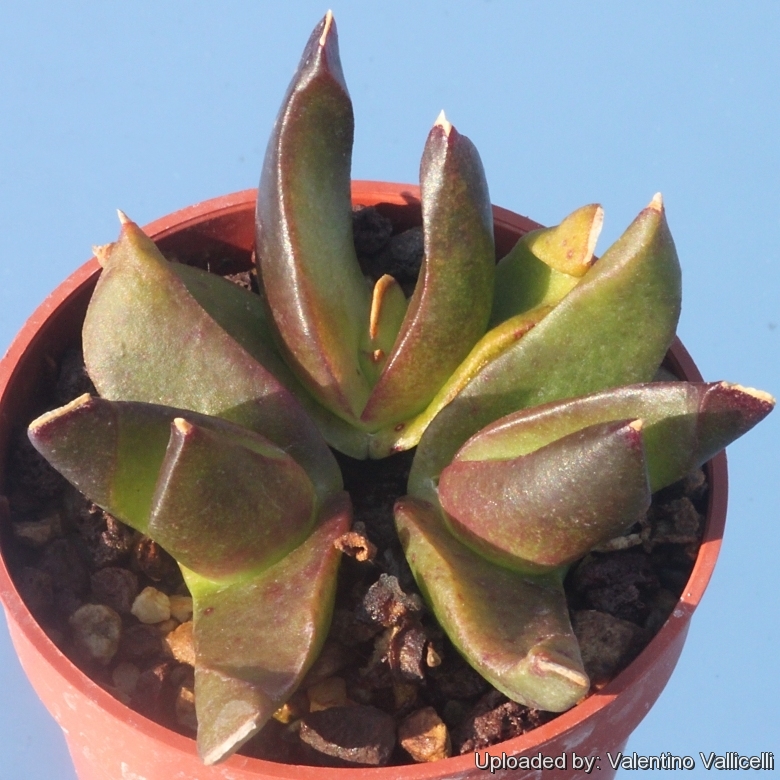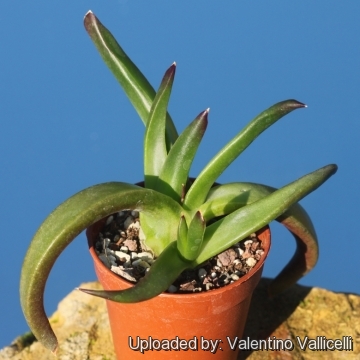Accepted Scientific Name: Glottiphyllum depressum (Haw.) N.E.Br.
Gard. Chron. 3, 70: 327 1921

Mesembryanthemum depressum (Glottiphyllum depressum) Photo by: Valentino Vallicelli
Klipdrif, 5 km south Zebra (MG1522.4621)
Origin and Habitat: From Ceres to Uniondale,Western Cape, South Africa.
Altitude: 500 - 980 m.
Habitat and ecology: They grow under shrubs on shaly sandstone or loamy soil, rarely in the open, rainfall p.a. less than 400 mm, often the only species of the genus in the area, in particular in shrubby vegetation types. The growing period of these plants is in summer. Mainly bees pollinate the flowers during the day. In the evening the pollinators are most likely to be moth species.
Synonyms:
See all synonyms of Glottiphyllum depressum
back
Accepted name in llifle Database:Glottiphyllum depressum (Haw.) N.E.Br.Gard. Chron. 3, 70: 327 1921Synonymy: 37
back
Common Names include:
ENGLISH: Fig-Marigold, Tongue-leaf, Tongue-leaved Mesemb
AFRIKAANS (Afrikaans): Vygie, Tongblaarvygie, Skilpadkos
Description: Glottiphyllum depressum is a small succulent, forming compact moderately branched groups of low, clustered rosettes with narrow tongue or strap-shaped leaves. Due to its very wide geographical area, variation is considerable.
Stem: Stemless or nearly so, often prostrate, internodes not visible.
Leaves: Decumbent to ascending, soft to the touch, translucent, glossy green, 3 or 4 pairs to a branch, closely packed in two ranks along the short stems, the pairs are united at the base,often of unequal length, tips of leaves with a more or less distinct hook from the marked impression of the opposite leaf. Leaves of seedlings acutely pointed.
Flowers: yellow up to 5 cm across.
Blooming season (Northern emisphere): December to late June, its peak flowering time being march. The flowers tend to open fully from 11:00 am as do many other Aizoaceae species. The reason for this is the need for sufficient sunlight and warmth, flowers last for several weeks.
Fruit: Spongy, tumble fruit, top very high, mostly higher than base, valves very thick, rims low, valve wings broad or reduced to awns;
Seed: Round, papillate, 1,1-1,35 mm long, 0,85-1,1 mm broad. Seed matures nearly five months after flowering.
Remarks: Glottiphyllum capsules are hygrochastic, an intriguing mechanism whereby seeds are dispersed by raindrops. When it rains, the keels of the wet seed capsules push open valves. Raindrops hitting the open seed capsule splatter seeds in different directions, thus ensuring recruitment and the subsequent survival of the species.
Subspecies, varieties, forms and cultivars of plants belonging to the Glottiphyllum depressum group
 Glottiphyllum depressum (Haw.) N.E.Br.: forms branched groups of low, clustered rosettes with narrow tongue or strap-shaped leaves, variation is considerable. Distribution: From Ceres to Uniondale,Western Cape, South Africa.
Glottiphyllum depressum (Haw.) N.E.Br.: forms branched groups of low, clustered rosettes with narrow tongue or strap-shaped leaves, variation is considerable. Distribution: From Ceres to Uniondale,Western Cape, South Africa. Glottiphyllum muirii N.E.Br.: has narrow strap-shaped leaves curving upwards at the tip to a blunt hook, rounded on the back. Phisantefontein, Little Karroo, (Cape Province) South Africa.
Glottiphyllum muirii N.E.Br.: has narrow strap-shaped leaves curving upwards at the tip to a blunt hook, rounded on the back. Phisantefontein, Little Karroo, (Cape Province) South Africa.
Bibliography: Major references and further lectures
1) Heidrun E.K. Hartmann “Illustrated Handbook of Succulent Plants: Aizoaceae F-Z” Springer Science & Business Media, 2002
2) Gideon Smith u.a. “Mesembs of the World: Illustrated Guide to a Remarkable Succulent Group.” Briza Publications, 1998
3)Hermann Jacobsen “A handbook of succulent plants: descriptions, synonyms, and cultural details for succulents other than Cactaceae, Volume 1” Blandford Press, 1960
4) Werner Rauh “The Wonderful World of Succulents:Cultivation and Description of Selected Succulent Plants Other Than Cacti” Smithsonian Institution Press, 1984
5) James Cullen, Sabina G. Knees, H. Suzanne Cubey “The European Garden Flora Flowering Plants: A Manual for the Identification of Plants Cultivated in Europe, Both Out-of-Doors and Under Glass” Cambridge University Press, 11/Aug/2011
6) Court. "Succulent flora of southern Africa" 1981
7) Vlok, J. and Schutte-Vlok, A.L. "Plants of the Klein Karoo." Umdaus Press, Hatfield. 2010
8) Victor, J.E. 2005. Glottiphyllum depressum (Haw.) N.E.Br. National Assessment: Red List of South African Plants version 2014.1. Accessed on 2015/05/21
 G. depressum Klipdrif, 5 km south Zebra, very nice form. (Glottiphyllum depressum) Photo by: Valentino Vallicelli
G. depressum Klipdrif, 5 km south Zebra, very nice form. (Glottiphyllum depressum) Photo by: Valentino VallicelliSend a photo of this plant.The gallery now contains thousands of pictures, however it is possible to do even more. We are, of course, seeking photos of species not yet shown in the gallery but not only that, we are also looking for better pictures than those already present.
Read More... Cultivation and Propagation: The plants in this genus represent some of the more easily cultivated succulent species. Their main growth period is in late winter and were heading for spring-summer dormancy, but they do best with at least a little water all year. Requires little water otherwise their epidermis breaks (resulting in unsightly scars). Water moderately from the middle of summer to the end of winter, and keep the compost almost dry when the plants are dormant. Water minimally in spring and summer, only when the plant starts shrivelling (, but they will generally grow even in summer if given water) In areas prone to frost, grow in an intermediate greenhouse or conservatory, in pots of cactus compost, obtainable from good garden centres. Keep cool and shaded in summer, but provide maximum light the rest of the year. Remember that a sunny locality is best, otherwise they will not flower properly. However there are two ways to grow glottiphyllums: The first is to let nature take her course, which means giving them large pots and copious water; they will burgeon into enormous masses of glistening green leaves. The other is to starve them into svelteness by hot summer droughts, small pots, and firm loam. The results can be very attractive. In any case it is best to treat them as late winter growers. Soft leaves mean easy to damage. May be susceptible to mealybugs.
Propagation: Seeds or cuttings. Seeds germinate very easily and can be sown in early to mid-spring, but can be sown at most times of the year (Avoid very hot weather in summer) and germinated in heated humid environment. Do not sow the seeds too deep. If sown too deep, they will be smothered and probably not germinate. Under ideal conditions, seedlings will grow rapidly. Plant the seedlings out when they are 3–5 cm in height.
Alternatively, use stem cuttings taken towards the end of summer in an heated propagating case (15-21°C) Cuttings root easily and remain true to the species, while seeds tend to hybridize.











